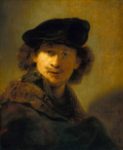
When done well, artfully expressing chiaroscuro gives the eyes lots to see in both the brightest parts of the image as well as in the darkest. The sense of depth can be profoundly interesting in such images. I like to say “Light without shadows is nothing, because shadows are where the secrets hide.” I enjoy getting lost in the shadows. Do you?
Now, let’s talk about chiaroscuro.
You might want to know first that Wiki says about chiaroscuro “..in art, is the use of strong contrasts between light and dark, usually bold contrasts affecting a whole composition.” The images below are classical chiaroscuro.

 Chiaroscuro is an old fashion style of art, dating from the 1700s masters of portrait, still life, and genre painters like Caravaggio and Rembrandt. But it’s popularity has never gone away. Thomas Cole, Thomas Moran, and Albert Bierstadt, painters from the Hudson Valley School (1800s) extended the chiaroscuro style to landscapes. There are many contemporary painters and photographers who continue to make images in the chiaroscuro style, including me.
Chiaroscuro is an old fashion style of art, dating from the 1700s masters of portrait, still life, and genre painters like Caravaggio and Rembrandt. But it’s popularity has never gone away. Thomas Cole, Thomas Moran, and Albert Bierstadt, painters from the Hudson Valley School (1800s) extended the chiaroscuro style to landscapes. There are many contemporary painters and photographers who continue to make images in the chiaroscuro style, including me.



The only reason I’m even talking about chiaroscuro is because I absolutely love this style of imagery, and I think you probably do too since you’re reading this newsletter. After all, the strong use of shadows and light is a consistent feature in my own photographs, as in “Foot of the Fall” above.
In my implementation of chiaroscuro, I like to follow what I see in the old masters’ paintings. There’s always lots of delicate highlights, which are made more compelling by lots of delicate, revealing shadows. Note I didn’t say featureless whites and sooty, blank blacks. To me, featuring huge paper white spaces or pure black spaces is the farthest thing from true chiaroscuro.
When done well in photography, chiaroscuro should almost seem like the highlights are dancing with the shadows. One moves into the space of the other without stepping on toes or losing the natural rhythm. Neither is dominant; they are in perfect balance. And very difficult to achieve, even when I find natural compositions that might lend themselves to this treatment.
But I’ll keep looking for those that do.
Do you like this style of imagery? Do your eyes lock to one end of the light range over the other (highlights or shadows)? Or do they flick back and forth in search of secrets?
Until next time,
Jim
 Did you enjoy this edition of Friday Foto? Feel free to share this article with someone you think might also enjoy it, and invite them to subscribe to “Under the Darkcloth.” And please leave me a comment or ask a question by replying to this email.
Did you enjoy this edition of Friday Foto? Feel free to share this article with someone you think might also enjoy it, and invite them to subscribe to “Under the Darkcloth.” And please leave me a comment or ask a question by replying to this email.
Copyright J. Riley Stewart, 2018, all rights reserved.
